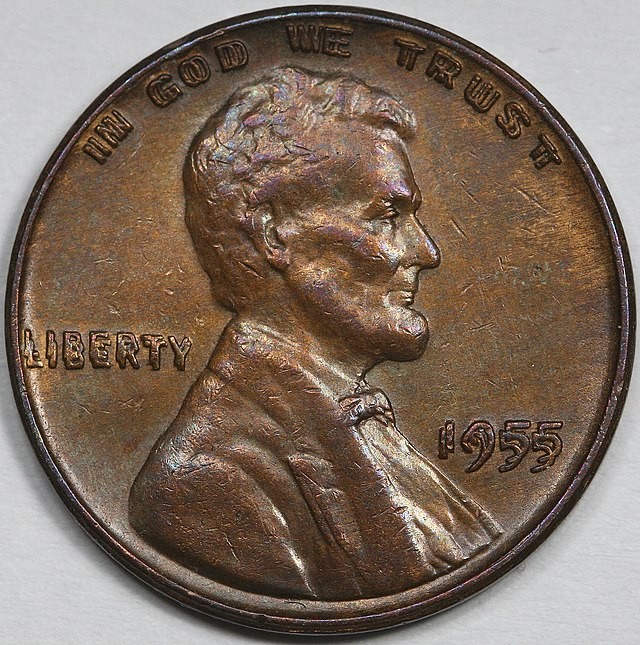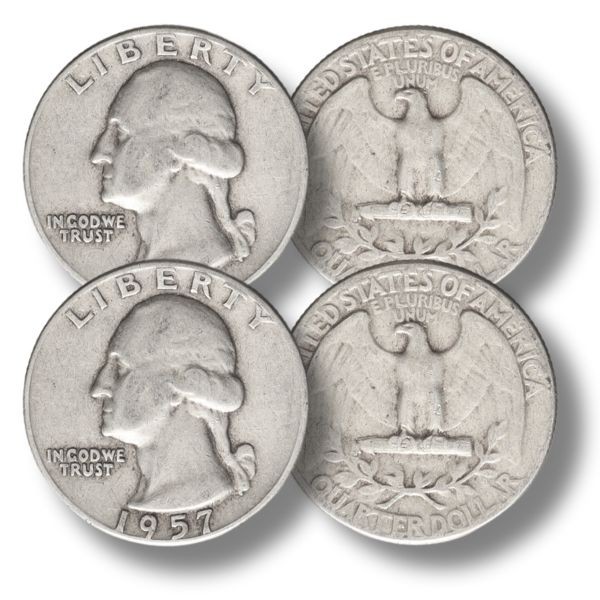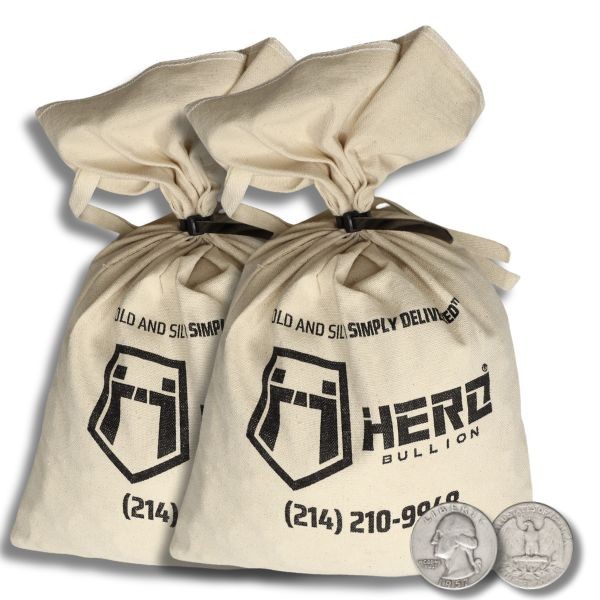Is a 1965 US quarter burning a hole in your pocket, and you’re wondering about its true worth? At HOW.EDU.VN, we understand the allure of old coins and the potential hidden value they might hold. While most 1965 quarters are common, certain rare variations, especially those with minting errors or exceptional condition, can be surprisingly valuable, sometimes fetching thousands of dollars. Let’s delve into the factors influencing the value of a 1965 quarter, including its condition, potential errors, and the elusive possibility of it being a silver quarter. Understanding these nuances will help you accurately assess the true worth of your coin.
1. Understanding the 1965 Quarter: A Transition in Coinage
The year 1965 marked a significant change in US coinage history with the passage of the Coinage Act of 1965. This act eliminated silver from circulating dimes and quarters, replacing it with a copper-nickel clad composition. Before this act, quarters were made of 90% silver.
1.1 Composition and Design
- Pre-1965: 90% silver, 10% copper
- Post-1964 (including 1965): Copper-nickel clad (75% copper, 25% nickel) bonded to a core of pure copper.
The design remained the same, featuring George Washington on the obverse (front) and an eagle on the reverse (back).
1.2 The Significance of 1965
The 1965 quarter was the first year of this new composition, marking the end of an era for silver coinage in general circulation. Over 1.8 billion 1965 quarters were minted, making them very common.
2. Factors Determining the Value of a 1965 Quarter
Several factors determine the worth of a 1965 quarter. Let’s explore each in detail:
2.1 Condition (Grade)
The condition, or “grade,” of a coin is the most critical factor in determining its value. Coin grading is a standardized system, with grades ranging from Poor (barely identifiable) to Mint State (perfect, uncirculated condition).
2.1.1 Grading Scale
Here’s a simplified overview of common coin grades:
- Poor (P): Heavily worn, details barely visible.
- Fair (FR): Very worn, some details visible.
- Good (G): Worn, but major design elements are visible.
- Very Good (VG): Moderately worn, details are clear.
- Fine (F): Lightly worn, details are sharp.
- Very Fine (VF): Slightly worn, details are crisp.
- Extremely Fine (EF or XF): Very light wear, almost all details are present.
- About Uncirculated (AU): Minor wear, mostly on high points of the design.
- Mint State (MS): Uncirculated, no wear, original luster. Grades range from MS-60 to MS-70, with MS-70 being perfect.
2.1.2 Impact of Condition on Value
Most circulated 1965 quarters (grades G to VF) are worth only their face value (25 cents) or slightly more (perhaps $0.50 to $1) due to their commonality. However, uncirculated (MS) coins can command a premium, with higher grades fetching significantly more.
2.2 Mint Errors
Mint errors occur during the coin production process. These errors can be highly sought after by collectors, significantly increasing a coin’s value.
2.2.1 Common Types of Mint Errors
- Doubled Die: Occurs when the die (used to strike the coin) has a doubled image. Look for doubling on the date, “Liberty,” or “In God We Trust.”
- Off-Center Strike: The coin is struck off-center, resulting in a partial image.
- Broadstrike: The coin is struck without the collar (a retaining ring), causing it to spread out and become wider than normal.
- Clipped Planchet: A piece of the coin is missing due to a defect in the metal blank (planchet).
2.2.2 1965 Doubled Die Quarter
The 1965 doubled die quarter is a notable error coin. It exhibits doubling on the inscriptions “LIBERTY” and “IN GOD WE TRUST,” and sometimes on the date. These errors are rare and can command a premium from collectors.
2.3 The Elusive 1965 Silver Quarter
Perhaps the most sought-after 1965 quarter is the silver variety. As mentioned earlier, the Coinage Act of 1965 eliminated silver from quarters. However, some believe that a few 1965 quarters were accidentally struck on leftover silver planchets from 1964.
2.3.1 Identifying a Silver Quarter
- Weight: A regular 1965 quarter weighs 5.67 grams. A 90% silver quarter weighs 6.25 grams. This is the most reliable method, using a precise scale.
- Color: A silver quarter will have a different luster and a slightly “whiter” appearance than a copper-nickel clad quarter. The edge of a clad quarter will show a copper stripe, while a silver quarter will not.
- Ring Test: When dropped on a hard surface, a silver coin will produce a longer, clearer ring than a clad coin. This method is subjective and requires experience.
2.3.2 Rarity and Value
The existence of 1965 silver quarters is debated among numismatists (coin collectors). While no official records confirm their production, some purported examples have surfaced. If authenticated, a 1965 silver quarter would be extremely rare and valuable, potentially worth thousands of dollars.
3. Estimated Values of 1965 Quarters
Here’s a general guide to the estimated values of 1965 quarters, based on condition and potential errors:
| Grade | Estimated Value (Regular Quarter) | Estimated Value (Doubled Die) | Estimated Value (Potential Silver Quarter) |
|---|---|---|---|
| Poor (P) to Good (G) | $0.25 – $0.50 | $10 – $50 | Unknown, likely still valuable |
| Very Good (VG) to Fine (F) | $0.50 – $1.00 | $50 – $100 | Unknown, significant premium expected |
| Very Fine (VF) to EF (XF) | $1.00 – $2.00 | $100 – $250 | Potentially thousands of dollars |
| About Uncirculated (AU) | $2.00 – $5.00 | $250 – $500 | High potential value |
| Mint State (MS-60 to MS-63) | $5.00 – $10.00 | $500 – $1,000 | Very high value |
| Mint State (MS-64+) | $10.00 – $25.00+ | $1,000+ | Extremely high value |



Important Notes:
- These are just estimates. Actual values can vary based on market demand and the specific characteristics of the coin.
- Error coins (doubled die, off-center, etc.) should be evaluated by a professional numismatist for accurate grading and authentication.
- The value of a potential silver quarter is highly speculative due to its rarity and the difficulty in confirming its authenticity.
3.1 Example Values
As of 2024, here are a few examples of 1965 quarter values based on actual sales and listings:
- 1965 Quarter, MS-65: Typically sells for $22 – $28.
- 1965 Quarter, MS-67: Can fetch between $400 – $850.
- 1965 Quarter, MS-68: The highest graded example, valued around $16,500.
- 1965 Doubled Die Quarter, MS-64: Known to sell for at least $1,400.
These figures highlight the significant impact of condition and errors on the value of a 1965 quarter.
4. Where to Get Your 1965 Quarter Appraised
If you believe you have a valuable 1965 quarter (especially a potential silver quarter or a coin with a significant error), it’s essential to get it professionally appraised. Here are some options:
- Professional Coin Grading Services (PCGS) and Numismatic Guaranty Corporation (NGC): These are the leading third-party coin grading services. They authenticate, grade, and encapsulate coins, providing a widely recognized assessment of their condition and authenticity.
- Local Coin Dealers: Reputable coin dealers can offer appraisals and may be interested in purchasing your coin. Look for dealers who are members of professional organizations like the American Numismatic Association (ANA).
- Auction Houses: Major auction houses that specialize in coins can provide appraisals and sell your coin to a wide audience of collectors.
- Online Coin Forums: Online forums dedicated to coins, such as those on CoinTalk, can be a good resource for getting preliminary opinions. However, always verify information with a professional.
4.1 Benefits of Professional Appraisal
- Accuracy: Professional appraisers have the expertise and tools to accurately assess a coin’s grade, identify errors, and detect counterfeits.
- Objectivity: Third-party grading services provide an unbiased assessment of a coin’s condition, which is crucial for determining its value.
- Authentication: Appraisers can verify the authenticity of a coin, which is especially important for rare or potentially valuable specimens.
- Market Value: Appraisers can provide an estimate of a coin’s current market value, based on recent sales and market trends.
5. The Allure of Coin Collecting
Coin collecting, or numismatics, is a fascinating hobby that combines history, art, and finance. Coins are not just pieces of currency; they are tangible links to the past, reflecting the cultures, economies, and events that shaped them.
5.1 Why People Collect Coins
- Historical Significance: Coins offer a glimpse into the history of different civilizations and eras.
- Artistic Value: Many coins are miniature works of art, featuring intricate designs and craftsmanship.
- Investment Potential: Rare and well-preserved coins can appreciate in value over time, making them a potential investment.
- Hobby and Education: Coin collecting can be an engaging and educational hobby, fostering a deeper understanding of history, economics, and art.
- Personal Connection: Some collectors focus on specific themes, such as coins from their country of origin, coins featuring certain historical figures, or coins made of specific metals.
5.2 Tips for New Coin Collectors
- Start Small: Begin with a manageable budget and focus on a specific type of coin that interests you.
- Learn the Basics: Familiarize yourself with coin grading, terminology, and the factors that affect value.
- Join a Coin Club: Connect with other collectors to share knowledge, learn from experienced numismatists, and participate in coin shows and events.
- Buy from Reputable Sources: Purchase coins from trusted dealers, auction houses, or grading services to avoid counterfeits and overpaying.
- Protect Your Collection: Store your coins in protective holders or albums to prevent damage and maintain their value.
6. Connect with Experts at HOW.EDU.VN
Navigating the world of coin collecting, understanding numismatics, and assessing the true value of your coins can be complex. The challenges many enthusiasts face include finding trustworthy expert advice, understanding the grading process, and accurately identifying mint errors or rare variations.
6.1 How HOW.EDU.VN Can Help
At HOW.EDU.VN, we offer direct access to seasoned numismatists and financial experts who can provide personalized guidance. Our team can help you:
- Accurately Assess Your Coin’s Value: Get a professional opinion on your coin’s grade, potential errors, and estimated market value.
- Authenticate Rare Coins: Ensure the authenticity of your valuable coins, including potential silver quarters or error coins.
- Develop a Coin Collecting Strategy: Learn how to build a valuable and enjoyable coin collection based on your interests and budget.
- Understand Market Trends: Stay informed about the latest trends in the coin market and identify potential investment opportunities.
- Connect with a Community of Experts: Engage with a network of knowledgeable numismatists and financial experts who can answer your questions and provide ongoing support.
6.2 Overcome Your Challenges with Expert Guidance
Many coin collectors struggle with:
- Determining Authenticity: Identifying genuine coins from counterfeits can be difficult without expert knowledge.
- Understanding Grading Standards: The nuances of coin grading can be confusing, leading to inaccurate assessments of value.
- Identifying Mint Errors: Recognizing rare mint errors requires a trained eye and specialized knowledge.
- Finding Reliable Information: Sifting through the vast amount of information available online can be overwhelming and unreliable.
Our team at HOW.EDU.VN addresses these challenges by providing:
- Expert Authentication Services: Verify the authenticity of your coins with our experienced numismatists.
- Clear and Concise Grading Explanations: Understand the coin grading process with our easy-to-follow guides and expert analysis.
- Detailed Error Identification: Learn how to identify and value rare mint errors with our specialized resources.
- Trusted and Curated Information: Access reliable and up-to-date information from our team of experts.
6.3 Take the Next Step
Ready to unlock the true potential of your coin collection? Contact HOW.EDU.VN today to connect with our team of numismatists and financial experts. Let us help you navigate the fascinating world of coins and discover the hidden treasures in your collection.
Don’t let the value of your coins remain a mystery. Whether you’re a seasoned collector or just starting out, HOW.EDU.VN is your trusted partner for expert guidance and support.
7. FAQ: Understanding 1965 Quarter Values
Here are some frequently asked questions about 1965 quarters and their values:
1. How much is a regular 1965 quarter worth?
Most circulated 1965 quarters are worth only their face value (25 cents) or slightly more (perhaps $0.50 to $1). Uncirculated examples in high grades (MS-65 or higher) can be worth $10 to $25 or more.
2. What makes a 1965 quarter valuable?
The condition (grade) of the coin is the most important factor. Mint errors, such as a doubled die, can also significantly increase the value. The elusive 1965 silver quarter, if authenticated, would be extremely valuable.
3. How can I tell if my 1965 quarter is silver?
Weigh it. A regular 1965 quarter weighs 5.67 grams, while a 90% silver quarter weighs 6.25 grams. Also, look at the edge of the coin. A clad quarter will have a copper stripe, while a silver quarter will not.
4. What is a 1965 doubled die quarter?
A 1965 doubled die quarter is a coin that exhibits doubling on the inscriptions “LIBERTY” and “IN GOD WE TRUST,” and sometimes on the date. These errors are rare and can command a premium from collectors.
5. How do I get my 1965 quarter appraised?
You can get your coin appraised by a professional coin grading service (PCGS or NGC), a local coin dealer, or a major auction house that specializes in coins.
6. Where can I sell my 1965 quarter?
You can sell your coin to a coin dealer, at an auction, or online through platforms like eBay or specialized coin marketplaces.
7. Is it worth getting a common 1965 quarter graded?
Generally, it’s not worth getting a common, circulated 1965 quarter graded, as the grading fees would likely exceed the coin’s value. However, if you believe you have an uncirculated example in exceptional condition or a potential error coin, grading may be worthwhile.
8. What is the highest grade a 1965 quarter can receive?
The highest grade a coin can receive is MS-70 (Mint State-70), which represents a perfect, flawless coin.
9. How many 1965 quarters were minted?
Over 1.8 billion 1965 quarters were minted, making them a very common coin.
10. Where can I find more information about coin collecting?
You can find more information about coin collecting from the American Numismatic Association (ANA), online coin forums, and reputable coin dealers and grading services. You can also connect with our experts at HOW.EDU.VN for personalized guidance.
Ready to Discover the True Value of Your Coins?
Don’t let your questions about coin values go unanswered. Contact the experts at HOW.EDU.VN today for personalized advice and guidance. Whether you’re curious about a 1965 quarter or any other coin in your collection, we’re here to help you unlock its true potential.
Contact Us Today:
- Address: 456 Expertise Plaza, Consult City, CA 90210, United States
- WhatsApp: +1 (310) 555-1212
- Website: HOW.EDU.VN
At how.edu.vn, we connect you with over 100 renowned PhDs and experts worldwide, providing tailored solutions to your specific needs. Whether you’re seeking expert advice, professional guidance, or in-depth knowledge, our team is ready to assist. Don’t hesitate—reach out today and experience the power of expert consultation. Let us help you achieve your goals with confidence and clarity.